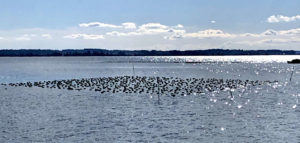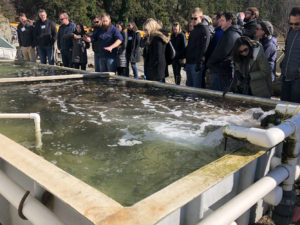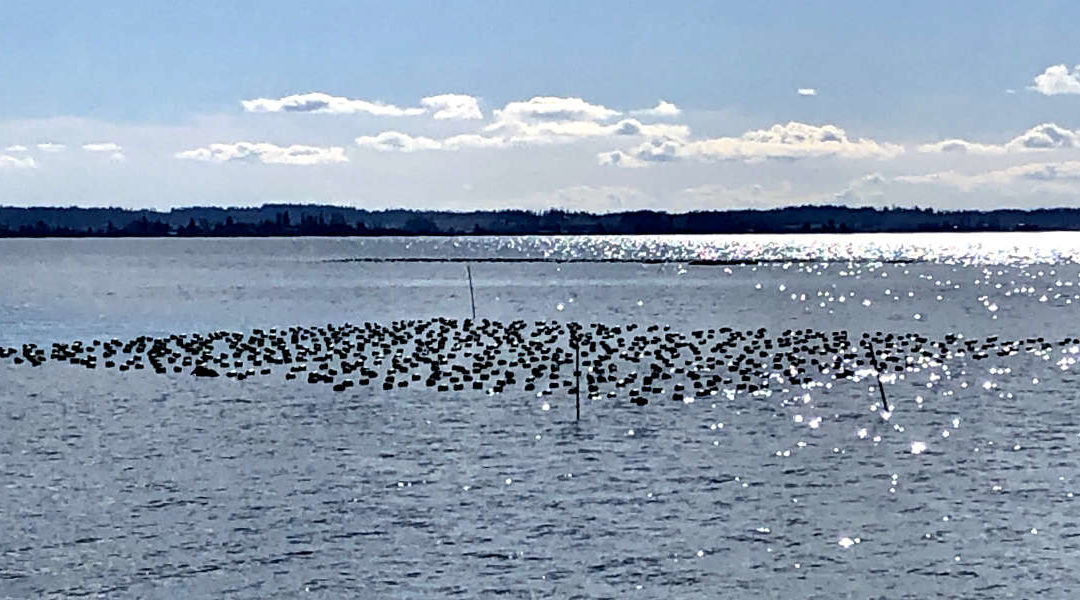“There is a shellfish farmer, sheep farmer and a vegetable farmer in a room of real estate development professionals.”

Samish Bay and Taylor Shellfish Farms
It’s the start of the classic “groan” joke. And, Yes!, it really happened! The sunny last day of February was a great day of learning with ULI- Northwest’s Center for Leadership class. The Salish Sea was shimmering, the tide was up at Taylor Shellfish Farms on Chuckunut Drive and the raw oyster shellfish lunch was delectable. Taylor Shellfish, the 120-year old family-owned business and shellfish operation on Chuckanut Drive, is a 45-minute drive south of Bellingham, Washington and home to a 1,900-acre farm hidden by high tides two times every day. Linda Neunzig, Snohomish County Agricultural Coordinator and owner of Ninety Farms outside of Arlington, Amy Moreno-Sills, PCC Farmland Trust’s Farm to Farmer Coordinator and co-owner of Four Element Farm in Pierce County, and Bill Dewey, Director of Public Relations for Taylor Shellfish and owner of Chuckunut Shellfish, imparted their wisdom on the perils and pleasures of farming. Each farmer further instilled a sense of urgency on remembering where our food comes from and why local farmland and farming is important. Farmland is not just open space.
Food is something we need every day to be vibrant, healthy, and at our peak performance. We expect it to be there whether at the grocery store, at an all you-can-eat buffet, at a local coffee shop, or just in the refrigerator when we wake up in the morning. We don’t think about where food comes from. We just take our food for granted.
Where Does Your Food Come From?
Linda set the stage both as a farmer and an agricultural advocate for Snohomish County. Right after the 9/11 tragedy she was in an elementary classroom outside of Everett, Washington, the next big city north of Seattle.
“Where does your food come from?” she asked the students.
The students shrugged their shoulders and scoffingly said, “The grocery store.” (Like, of course, isn’t that where all food comes from?)
Linda pursued the questioning further, “No, really, where does your food come from?”
With a shrug and disinterest, the students were silent.
With emphasis, Linda said, “A farm.”
The students nodded their heads, silently acknowledging and realizing, that yes, their food did come from a farm.
Linda drilled down further and asked, “There are only three to five days of food available in a grocery store. What if we can’t get food shipped in from Mexico and California? Is there enough farmland to feed the people in Snohomish County, if food can’t get here?”
The students halfheartedly nodded yes.
“If you think we can feed the people in Snohomish County, how will we feed the folks in King County? There are a lot more people with a lot more money in Seattle. How are we going to feed them them?”
The students got it. Locally grown food is a necessity for healthy, resilient, sustainable communities.
The Seattle area had just lived through Snowmageddon 2019 in February where grocery stores were stripped of produce and essentials, so the experience of not enough food at a grocery store was very real. Just as the elementary kids realized their food came from farms, the adults, too, had a gut reaction that food just doesn’t come from a grocery store, it comes from farms.

Cooking Paella
Food has been part of my life forever. Yes, I eat! I have deep roots in food. As a teenager, my first vegetable garden was filled with green beans and tomatoes, which continue to be “green thumb” mainstays. In the 1990’s, my livelihood depended on food. I secured real estate sites and permitted Haggen’s grocery stores in the Pacific Northwest. For five years I served as a PCC Community Markets board member approving new grocery sites, developing policy to reward co-op members, and ensuring the co-op’s financial stability. Beginning in 2006, I started a four-year stint as PCC Farmland Trust’s Executive Director, placing conservation easements on vulnerable farmland, raising (at the height of the recession) significant capital to save at-risk farmland, and doubling the number of donors committed to preserving valuable, productive farmland. I developed a fuller understanding of the joys and more importantly the challenges of farming. I, too, humbly realized, I had taken my food for granted. I vowed to continue to work to protect and respect farmland and the farmers that grow our food.
All food, whether at the grocery store, restaurants, sporting events, you name it, comes from farmers. Farmers grow the food on which we are so dependent and we probably never think of thanking them for their work. Farmers are dependent on farmable land and clean, adequate quantities of water to grow the food we eat. Oh, and sun helps, too!
Real estate professionals are dependent on the same resources–land and water–in their business to build communities and cities. Hence putting three farmers in the same room with a group of real estate professionals is an amazing opportunity to cross pollinate understandings and information.
The Farmers’ Livelihoods
Linda, Amy, and Bill all have two jobs-they run their farm and have a “day” job. Linda Neunzig works a full-time “day job” for Snohomish County advocating for the preservation of farmland and the farming economy. If a farmer goes out of business or sells property to a developer, the farmland is lost forever. It impacts the farm economy and the strength of the food growing profession. For a vibrant farm economy, farmers need support infrastructure and enough farms to support a thriving farm economy. Think about it, the dairy economy needs large-animal veterinarians, feed and supply stores, large machinery suppliers, and processing facilities for milk. If there is not enough commerce for the dairy agricultural support businesses, they go out of business. While advocating for the farm economy, Linda also runs Ninety Farms, a purebred Katahdin sheep and lambing business that just birthed its 2,600th lamb! She butchers animals for fine restaurants and discerning customers and sells breeding lambs to other farmers worldwide. Both professions keep her quite busy.
Amy Moreno-Sills, with her husband Augustin, farm Four Elements Farm on 56 acres in the fertile Puyallup Valley in Pierce County on property that was conserved by PCC Farmland Trust. Four Elements Farm specializes in bringing healthy, wholesome food to the community and their loyal Community Supported Agricultural (“CSA”) customers. The farm is blessed with 70-year old blueberry bushes where customers can U-pick in season. The farm store is set in the middle of the fields and the business is centrally located between the bustling communities of Puyallup and Orting. Not that she doesn’t have enough to do, Amy’s “day job” is to link farms to farmers and visa versus. She ensures new and expanding farmers have access to available land and retiring farmers have an financially rewarding way to sell their land to a farmer.
Bill Dewey’s almost 30-year “day job” as Director of Public Relations for Taylor Shellfish Farms keeps him hopping to ensure that Samish Bay continues to be a healthy, productive shellfish environment. His other job, a manila clam and geoduck farm business is also located in Samish Bay. During our haven for the day at Taylor Shellfish, Bill emphasized the importance of clean, healthy, cool seawater as critical to growing the best mussels, clams, and oysters.

Oyster Farm at Taylor Shellfish Farms
Bill said that usually only 700 acres of the 1,900 acres of tidelands owned Taylor are farmed at one time. Shellfish delicacies are “planted” regularly at lower tides and harvested as demanded by markets in Seattle and worldwide. Despite what appears to be a large operation on Chuckanut Drive, Taylor’s main office and farm are in Shelton, Washington. With expanding markets and changing seawater conditions, Taylor has had adapt and change their business model. Ocean acidification from a changing climate has impacted how Taylor runs their $68 million worldwide business. Rather than growing seed in the ocean, they are now grown in a laboratory environment in Hawaii to ensure that the seed reaches a large enough mature size to withstand the more challenging natural now slightly more acid seawater home. Stormwater discharge from the built environment, agriculture or other land-based activities greatly impacts seawater health for shellfish or any sea-based food. Fertilizers, car emissions and oils, and inadequate stormwater control facilities can all compound to tip the balance towards inferior water quality to grow healthy sea crops.
Once out of the laboratory, oysters begin their lives as mere specks eventually attaching themselves to old oyster shells. The fertilized shells are bagged and hung on cords that are stretched between posts in the shallow Samish Bay aqua farm. The Samish Sea tides flow in and out twice a day bringing fresh seawater and nutrients to nurture the fledgling bivalves. Once the oysters have grown to full size, they are harvested and shipped to discerning customers. To educate and bring the good seafood story and delicacies to urbanites, Taylor Shellfish has opened multiple oyster and shellfish bars not only on Chuckanut Drive but also in Seattle and Bellevue!
The Follow-up Chatter
After the panel discussion, Linda spoke with a developer on how his firm purchased King County Regional Development Credits for their upzone in Seattle’s South Lake Union neighborhood to build more housings units than originally allowed by the zoning code. Linda explained, “This is the classic Transfer of Development Rights land use tool that is used to protect farmland and forestland from development.”

Sprouting Oysters
Transfer of Development Rights (“TDR”) programs were created more than 20 years, but only now are becoming useful and powerful tools to bring density into the cities, while preserving rural lands for farming and forests. How does a TDR program work? A rural land owner sells the rights to develop her property to a government entity such as a County. For example, a farm owner has 100 acres and has a zoning code right to divide the property into ten lots at ten acres each, consequently creating 10 development rights or building lots. Often a landowner will keep at least one development right for an existing home on the property. The County buys the appraised value of the remaining nine development rights from the landowner. The value of each development right is the appraised cost that a landowner would garner for selling the property to a real estate developer. The County holds the development right in a “bank,” until a developer purchases the development right from the County to increase a building’s density or height in a city. These TDRs or in the City of Seattle parlance Regional Development Credits have been used to create more density in the South Lake Union neighborhood and other places in western Washington.
And what was exciting to hear was the spontaneous chatter after the panel presentation. Two or three guys in the back of the room were bantering and one said, “Wow, that presentation blew my mind.” The energy was high in their conversation about their realization of agriculture’s vital importance in the Seattle region, for cities, for people, and our quality of life. The health of agriculture is challenged in our region. Ultimately our own health and the region’s health and prosperity is vulnerable and inextricably linked to the health and vibrancy of agriculture.
Kathryn Gardow, P.E., is a local food advocate, land use expert and owner of Gardow Consulting, LLC, an organization dedicated to providing multidisciplinary solutions to building sustainable communities. Kathryn has expertise in project management, planning, farmland conservation, and civil engineering, with an emphasis on creating communities that include food production. Kathryn’s blog muses on ways to create a more sustainable world and good food!

